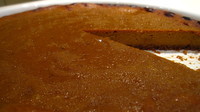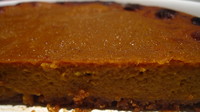Pumpkin pie
 Oct 12, 2015
—
Dessert
Oct 12, 2015
—
Dessert
The OED defines pie as a baked dish with a sweet or savoury filling that has a bottom and/or top crust (typically pastry, but take pity on the humble Shepherd’s pie, topped with mashed potato). The word also appears in bird names (e.g., magpie) and was probably used to compare the variety of pie fillings to the random objects stolen by thieving magpies. In Australia, the word pie (in the absence of any qualifiers) describes any pastry-crusted item with a savoury meat filling (beef, chicken, lamb, pork). It rarely serves double-duty to describe a sweet dessert (e.g., apple pie) and never when used in isolation.
Pumpkin pie is a staple of Halloween, Thanksgiving and Christmas celebrations in North America. It has a reputation for being difficult to make from scratch and the most common recipes call for canned pumpkin pie filling (with spices included). This reduces the cook’s responsibilities to preparing the pie crust (or using a pre-made crust, quelle horreur!), pouring in the filling, and placing it in the oven.
Today being Canadian Thanksgiving — the second Monday in October — we decided to make a pumpkin pie from scratch. One of the most frequent mistakes is using a pumpkin of the type commonly used for carving Halloween decorations. I’m not sure I’ve ever seen this variety of pumpkin for sale in a Melbourne grocery store1, so this mistake was easily avoided; we used Kent pumpkin (also known as Japanese pumpkin or kobacha), which is sweeter than butternut pumpkin. Other common problems include the pumpkin purée being too watery, and not having the right combination of spices to taste like a real pumpkin pie.
 The good news is that we managed to make a pie that tasted right (according to
my Canadian wife, that is — I’ve only had pumpkin pie once before) and it
didn’t require a huge amount of effort; most of the time was spent letting
things cool or bake.
The only problem we encountered was that our oven is apparently a quick oven
and cooked the pie in about half the expected time, with a slight amount of
burning around the edge (see right).
The good news is that we managed to make a pie that tasted right (according to
my Canadian wife, that is — I’ve only had pumpkin pie once before) and it
didn’t require a huge amount of effort; most of the time was spent letting
things cool or bake.
The only problem we encountered was that our oven is apparently a quick oven
and cooked the pie in about half the expected time, with a slight amount of
burning around the edge (see right).
 I suppose we did cheat a little by using Granita biscuits to make a
cheesecake-style crust rather than a pastry crust, but isn’t it all about the
pumpkin flavour, not the crust?
The custard filling was sufficiently cohesive to hold everything together
(much like a cheesecake, see right) and so our laziness only gave the pie a
nice, crunchy base.
By the way, it was only via baking that I encountered the North American
equivalent, Graham crackers, and learnt that Graham is a single-syllable
word in North America
(pronounced as gram,
not gray-am).
I suppose we did cheat a little by using Granita biscuits to make a
cheesecake-style crust rather than a pastry crust, but isn’t it all about the
pumpkin flavour, not the crust?
The custard filling was sufficiently cohesive to hold everything together
(much like a cheesecake, see right) and so our laziness only gave the pie a
nice, crunchy base.
By the way, it was only via baking that I encountered the North American
equivalent, Graham crackers, and learnt that Graham is a single-syllable
word in North America
(pronounced as gram,
not gray-am).
Pumpkin purée
- 1 kg Kent pumpkin (about half a pumpkin)
- Remove the seeds and scrape the inner cavity clean.
- Place the pumpkin cut-side-down on a foil-lined baking dish and cover with a small amount of oil.
- Bake at 190 °C until fork-tender (about 40–45 minutes).
- Leave to cool.
- Scoop out the flesh and blend (e.g., with a stick blender).
- Drain the purée in a fine-meshed sieve or muslin bag for at least one hour.
Pie filling
Prepare the filling one day in advance and refrigerate, to allow the spices to blend and improve the flavour. For no apparent reason, condensed milk comes in 397 g tins.
- Pumpkin purée (see above)
- 400 g sweetened condensed milk
- 2 tsp ground cinnamon
- 1 tsp vanilla extract
- 1 tsp ground ginger
- 1 tsp orange zest
- ½ tsp salt
- ½ tsp ground cardamom
- ½ tsp ground cloves
- ½ tsp ground nutmeg
- ⅛ tsp ground black pepper
- 3 large eggs
- Mix dry ingredients in a small bowl.
- Beat eggs in a large bowl.
- Stir in pumpkin purée, spices, vanilla extract and zest.
- Gradually stir in condensed milk.
Pie crust
The quantity of butter could probably be reduced (say, to 60 g).
- 150 g Granita biscuits
- 50 g brown or raw sugar
- 75 g unsalted butter, melted
- ½ tsp ground cinnamon
- Crush the biscuits (e.g., place in a zip-lock bag and use a rolling pin).
- Combine all ingredients in a metal bowl with a spatula.
- Firmly press the mixture into the pie dish, making sure it is compacted (press down with, e.g., a flat-bottomed metal measuring cup).
- Bake for around 8 minutes (175 °C) to 10 minutes (150 °C).
- Cool on a rack or bench top (1-2 hours) then refrigerate for 1 hour.
Assembly
In our oven, the pie began to burn slightly around the edges after about 12 minutes at 220 °C, and only required a further 23 minutes at 175 °C. Next time, we’ll reduce the temperature for both stages of the baking.
- Pour the filling into the pie dish.
- Bake at 220 °C for 15 minutes; 175 °C for 40–50 further minutes. A knife inserted near centre should come out clean. Remove from oven while the centre is still wobbly, since overcooking it will cause the filling to crack.
- Cool on wire rack for 2 hours, then serve or refrigerate.
1 comment
"Halloween pumpkins" have appeared in our local supermarket, as has a "Mini Jack" variety the size of a navel orange. Apparently this isn't the first time.
Rob October 25, 2015